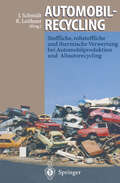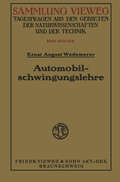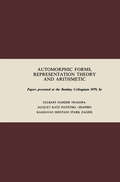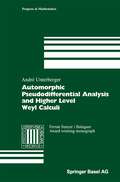- Table View
- List View
Automobility and the City in Twentieth-Century Britain and Japan (SOAS Studies in Modern and Contemporary Japan)
by Simon Gunn Susan C. TownsendAutomobility and the City in Twentieth-Century Britain and Japan is the first book to consider how mass motorization reshaped cities in Japan and Britain during the 20th century. Taking two leading 'motor cities', Nagoya and Birmingham, as their principal subjects, Simon Gunn and Susan C. Townsend show how cars changed the spatial form and individual experience of the modern city and reveal the similarities and differences between Japan and Britain in adapting to the 'motor age'. The book has three main themes: the place of automobility in post-war urban reconstruction; the emerging conflict between the promise of mobility and personal freedom offered by the car and its consequences for the urban environment (the M/E dilemma); and the extent to which the Anglo-Japanese comparison can throw light on fundamental differences in cultural understanding of the environment, urbanism and the self. The result is the first comparative history of mass automobility and its environmental consequences between East and West.
Automobility in Transition?: A Socio-Technical Analysis of Sustainable Transport (PDF) (Routledge Studies In Sustainability Transition Ser.)
by Frank W. Geels René Kemp Geoff Dudley Glenn LyonsIs the automobility regime experiencing a transition towards sustainability? To answer that question, this book investigates stability and change in contemporary transport systems. It makes a socio-technical analysis of transport systems, exploring the strategies and beliefs of crucial actors such as car manufacturers, local and national governments, citizens, car drivers, transport planners and civil society. Two guiding questions are: Will we see a greening of cars, based on technological innovations that sustain the existing car-based system? Or is something more radical desirable and likely, such as the development of travel regimes in which car use is less dominant?
Automobillogistik: Stand und Zukunftstrends
by Ingrid Göpfert David Braun Matthias SchulzDieses Buch zeigt anhand anschaulicher Beispiele und Fallstudien die wichtigsten Zukunftstrends in der Logistik und im Supply Chain Management der Automobilwirtschaft. Es bietet zahlreiche Einblicke und Anregungen für Industrie-, Handels- und Dienstleistungsunternehmen aus unterschiedlichen Branchen zur ganzheitlichen Planung und Steuerung von Supply Chains sowie zu den Themen Beschaffungs-, Produktions-, Distributions- und Ersatzteillogistik.
Automobillogistik: Stand und Zukunftstrends
by Ingrid Göpfert David Braun Matthias SchulzDieses Buch zeigt anhand anschaulicher Beispiele und Fallstudien die wichtigsten Zukunftstrends in der Logistik, im Supply Chain Management sowie in der Automobilwirtschaft. Es bietet zahlreiche Einblicke und Anregungen für Industrie-, Handels- und Dienstleistungsunternehmen aus unterschiedlichen Branchen zur ganzheitlichen Planung und Steuerung von Supply Chains sowie zu den Themen Beschaffungs-, Produktions-, Distributions- und Ersatzteillogistik.
Automobillogistik: Stand und Zukunftstrends
by Ingrid Göpfert David Braun Matthias SchulzDas Buch zeigt aus theoretischer und praktischer Sicht aktuelle und zukünftige Probleme und Lösungsmöglichkeiten der gesamten Logistikkette Automobilbau (OEMs, Zulieferer, Dienstleister). Mit zahlreichen anschaulicnen Beispielen und Fallstudien.
Automobilmarkt Südostasien: Erfolgsfaktoren japanischer Unternehmen
by Karin FunkeDer starke Yen und das Entstehen neuer Absatzmärkte haben zu immer mehr Investitionen japanischer Automobilhersteller in Südostasien geführt. Heute dominieren die Japaner den gesamten Markt in dieser Region.
Automobilrecycling: Stoffliche, rohstoffliche und thermische Verwertung bei Automobilproduktion und Altautorecycling
by Joachim Schmidt Reinhard LeithnerDas Thema Recycling wird gegenwärtig zwar verstärkt erörtert, es besteht jedoch noch ein sehr hoher Informationsbedarf bei den betroffenen Unternehmen. Ziel der Wiederverwertung ist es, möglichst viele Rohstoffe zurückzugewinnen, um so Ressourcen zu schonen und gleichzeitig die Anzahl und das Wachstum von Deponien zu vermindern. Auf dem Weg zu einer Kreislaufwirtschaft spielt die Verwertung von Altautos eine bedeutende Rolle. Bei der Vielzahl der zu verwertenden Stoffe entstehen jedoch auch zahlreiche technische Probleme. Diese Probleme werden hier jeweils von Experten aufgegriffen und entsprechende Lösungsvorschläge vorgestellt.
Automobilschwingungslehre (Sammlung Vieweg #103/104)
by Ernst August WedemeyerDieser Buchtitel ist Teil des Digitalisierungsprojekts Springer Book Archives mit Publikationen, die seit den Anfängen des Verlags von 1842 erschienen sind. Der Verlag stellt mit diesem Archiv Quellen für die historische wie auch die disziplingeschichtliche Forschung zur Verfügung, die jeweils im historischen Kontext betrachtet werden müssen. Dieser Titel erschien in der Zeit vor 1945 und wird daher in seiner zeittypischen politisch-ideologischen Ausrichtung vom Verlag nicht beworben.
Automorphe Formen (Masterclass)
by Anton DeitmarDas Buch bietet eine Einführung in die Theorie der automorphen Formen. Beginnend bei klassischen Modulformen führt der Autor seine Leser hin zur modernen, darstellungstheoretischen Beschreibung von automorphen Formen und ihren L-Funktionen. Das Hauptgewicht legt er auf den Übergang von der klassischen, elementaren Sichtweise zu der modernen, durch die Darstellungstheorie begründete Herangehensweise. Diese Art der Verbindung von klassischer und moderner Sichtweise war in der Lehrbuchliteratur bisher nicht zu finden.
Automorphe Funktionen und indefinite quadratische Formen (Sitzungsberichte der Heidelberger Akademie der Wissenschaften #1949 / 1)
by Hans MaassAutomorphic Forms (Universitext)
by Anton DeitmarAutomorphic forms are an important complex analytic tool in number theory and modern arithmetic geometry. They played for example a vital role in Andrew Wiles's proof of Fermat's Last Theorem. This text provides a concise introduction to the world of automorphic forms using two approaches: the classic elementary theory and the modern point of view of adeles and representation theory. The reader will learn the important aims and results of the theory by focussing on its essential aspects and restricting it to the 'base field' of rational numbers. Students interested for example in arithmetic geometry or number theory will find that this book provides an optimal and easily accessible introduction into this topic.
Automorphic Forms: Research in Number Theory from Oman (Springer Proceedings in Mathematics & Statistics #115)
by Bernhard Heim Mehiddin Al-Baali Tomoyoshi Ibukiyama Florian RuppThis edited volume presents a collection of carefully refereed articles covering the latest advances in Automorphic Forms and Number Theory, that were primarily developed from presentations given at the 2012 “International Conference on Automorphic Forms and Number Theory,” held in Muscat, Sultanate of Oman. The present volume includes original research as well as some surveys and outlines of research altogether providing a contemporary snapshot on the latest activities in the field and covering the topics of:Borcherds productsCongruences and CodesJacobi formsSiegel and Hermitian modular formsSpecial values of L-seriesRecently, the Sultanate of Oman became a member of the International Mathematical Society. In view of this development, the conference provided the platform for scientific exchange and collaboration between scientists of different countries from all over the world. In particular, an opportunity was established for a close exchange between scientists and students of Germany, Oman, and Japan. The conference was hosted by the Sultan Qaboos University and the German University of Technology in Oman.
Automorphic Forms and Even Unimodular Lattices: Kneser Neighbors of Niemeier Lattices (Ergebnisse der Mathematik und ihrer Grenzgebiete. 3. Folge / A Series of Modern Surveys in Mathematics #69)
by Gaëtan Chenevier Jean LannesThis book includes a self-contained approach of the general theory of quadratic forms and integral Euclidean lattices, as well as a presentation of the theory of automorphic forms and Langlands' conjectures, ranging from the first definitions to the recent and deep classification results due to James Arthur.Its connecting thread is a question about lattices of rank 24: the problem of p-neighborhoods between Niemeier lattices. This question, whose expression is quite elementary, is in fact very natural from the automorphic point of view, and turns out to be surprisingly intriguing. We explain how the new advances in the Langlands program mentioned above pave the way for a solution. This study proves to be very rich, leading us to classical themes such as theta series, Siegel modular forms, the triality principle, L-functions and congruences between Galois representations.This monograph is intended for any mathematician with an interest in Euclidean lattices, automorphic forms or number theory. A large part of it is meant to be accessible to non-specialists.
Automorphic Forms and Lie Superalgebras (Algebra and Applications #5)
by Urmie RayThis book provides the reader with the tools to understand the ongoing classification and construction project of Lie superalgebras. It presents the material in as simple terms as possible. Coverage specifically details Borcherds-Kac-Moody superalgebras. The book examines the link between the above class of Lie superalgebras and automorphic form and explains their construction from lattice vertex algebras. It also includes all necessary background information.
Automorphic Forms and the Picard Number of an Elliptic Surface (Aspects of Mathematics #5)
by Peter F. StillerIn studying an algebraic surface E, which we assume is non-singular and projective over the field of complex numbers t, it is natural to study the curves on this surface. In order to do this one introduces various equivalence relations on the group of divisors (cycles of codimension one). One such relation is algebraic equivalence and we denote by NS(E) the group of divisors modulo algebraic equivalence which is called the N~ron-Severi group of the surface E. This is known to be a finitely generated abelian group which can be regarded naturally as a subgroup of 2 H (E,Z). The rank of NS(E) will be denoted p and is known as the Picard number of E. 2 Every divisor determines a cohomology class in H(E,E) which is of I type (1,1), that is to say a class in H(E,9!) which can be viewed as a 2 subspace of H(E,E) via the Hodge decomposition. The Hodge Conjecture asserts in general that every rational cohomology class of type (p,p) is algebraic. In our case this is the Lefschetz Theorem on (I,l)-classes: Every cohomology class 2 2 is the class associated to some divisor. Here we are writing H (E,Z) for 2 its image under the natural mapping into H (E,t). Thus NS(E) modulo 2 torsion is Hl(E,n!) n H(E,Z) and th 1 b i f h -~ p measures e a ge ra c part 0 t e cohomology.
Automorphic Forms on Adele Groups. (AM-83), Volume 83 (PDF)
by Stephen S. GelbartThis volume investigates the interplay between the classical theory of automorphic forms and the modern theory of representations of adele groups. Interpreting important recent contributions of Jacquet and Langlands, the author presents new and previously inaccessible results, and systematically develops explicit consequences and connections with the classical theory. The underlying theme is the decomposition of the regular representation of the adele group of GL(2). A detailed proof of the celebrated trace formula of Selberg is included, with a discussion of the possible range of applicability of this formula. Throughout the work the author emphasizes new examples and problems that remain open within the general theory. TABLE OF CONTENTS: 1. The Classical Theory 2. Automorphic Forms and the Decomposition of L2(PSL(2,R) 3. Automorphic Forms as Functions on the Adele Group of GL(2) 4. The Representations of GL(2) over Local and Global Fields 5. Cusp Forms and Representations of the Adele Group of GL(2) 6. Hecke Theory for GL(2) 7. The Construction of a Special Class of Automorphic Forms 8. Eisenstein Series and the Continuous Spectrum 9. The Trace Formula for GL(2) 10. Automorphic Forms on a Quaternion Algebr?
Automorphic Forms on Semisimple Lie Groups (Lecture Notes in Mathematics #62)
by Bhartendu HarishchandraAutomorphic Forms, Representation Theory and Arithmetic: Papers presented at the Bombay Colloquium 1979 (Tata Institute Studies in Mathematics)
by S. Gelbart G. Harder K. Iwasawa H. Jaquet N.M. Katz I. Piatetski-Shapiro S. Raghavan T. Shintani H.M. Stark D. ZagierInternational Colloquium an Automorphic Forms, Representation Theory and Arithmetic. Published for the Tata Institute of Fundamental Research, Bombay
Automorphic Pseudodifferential Analysis and Higher Level Weyl Calculi (Progress in Mathematics #209)
by André UnterbergerAutomorphic Representation of Unitary Groups in Three Variables. (AM-123), Volume 123 (PDF)
by Jonathan David RogawskiThe purpose of this book is to develop the stable trace formula for unitary groups in three variables. The stable trace formula is then applied to obtain a classification of automorphic representations. This work represents the first case in which the stable trace formula has been worked out beyond the case of SL (2) and related groups. Many phenomena which will appear in the general case present themselves already for these unitary groups.
























